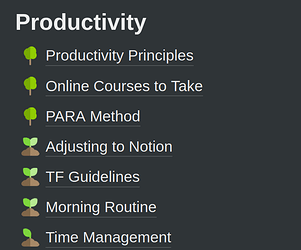This “note status” scenario really resonates with me. I’m using page icons in Notion for that:
Basically some custom icons that I upload to each note:
tree→ There’s a bunch of stuff written in that note.growing→ There’s some of the stuff in there, but it could be expanded upon.sprout→ There’s like a sentence or two written in there.
When I look into my “Topic Forest” (idea borrowed from Valentin Perez), I can quickly asses what I will get as a result before I click on the note.
The closest I can get to it now is to add something like 1-5 at the beginning of note’s name. This would be helpful, as it would allow me to add emojis to h1 tags to achieve similar results:
I’ve also thought about abusing tags for the purpose (add #1-5 to a note, allowing me to search for all notes that need to be worked on), but from a discovery perspective, it’d still require me to click on a note to see the which of the tags I’ve associated with it.
